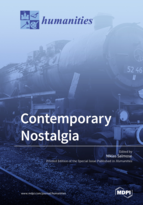Contemporary Nostalgia
A special issue of Humanities (ISSN 2076-0787).
Deadline for manuscript submissions: closed (15 September 2018) | Viewed by 79681
Special Issue Editor
Special Issue Information
Dear Colleagues,
We live in societies oriented towards the now and the tomorrow, in a world obsessed with a complex and protean present seemingly impervious to historical continuity. The many tomorrows inherent in every new technology, product, and digitally mediated event drive us further away from our collective histories. Yet the present seems stubbornly rooted in the past, as Zygmunt Bauman so convincingly argues in his last work Retrotopia (2017). This occurs both politically, as in the repeated re-ignition of history’s buried fires, ranging from the emergence of ISIS as an ultra-nostalgic force to the re-emergence of a nostalgic hard-right in European politics, and culturally, as in the persistent return of cultural production and consumption to a number of key points in our history in a restless and always unsatisfied attempt to reinterpret, reuse, or replay that which is seemingly vanished. This retrospective orientation is observable in all major contemporary media forms and social practices. Romantic inclination towards the past might seem irrational, but our emotional connections to our own biographies, as well as a collective solidarity with our childhoods, traditions, imaginations, anticipations and dreams may also be a rational response to modern instability. Nostalgia, then, appears increasingly to be a modality of its own with major potential for understanding how our now is shaped by our then, both individually and collectively.
Papers are invited that will discuss pressing contemporary issues (politics, social, climate, economics) through a nostalgic discourse and how these issues resonate in media, art and culture. Topics of interest include, but are not limited to, the following:
Memory, Affect, Subjectivity. Research within this field could explore the centrality of this sort of personal nostalgia to contemporary cultural production, examining key texts such as the Proustian project of Karl Ove Knausgård’s six-volume My Struggle.
Nostalgia and Empire. Empire and nostalgia permeate media of any kind even to this day. We see this in films like The English Patient (1996), for instance, as in computer games like Victoria: An Empire Under the Sun (2003), but we certainly also see it in the news, in the hopes that Brexit can reestablish the importance of a Britain reduced in power, or that electing Donald Trump can ‘Make America Great Again’ by returning to former days of military glory. Imperial nostalgia is here to stay. Indeed, some may argue that it never went away in the first place.
Migration and Exile. Who, indeed, could experience of the pain of the impossibility to return home implied in the etymology of the term nostalgia more acutely, more persistently, and more hopelessly, than the refugee or the exile, who all too often literally cannot go home or has no home to go home to. But as Charles C. Lemert has pointed out “dispossession” is the “ubiquitous condition of a globalizing world,” and thus not exclusive to literal communities of exile: global neo-liberal capitalism makes exiles out of us all, and one response to this state is nostalgia.
The Anthropocene, the Post-human, and Utopian-Dystopian Imaginaries. The fear of loss of stable humanity, both in the Anthropocene and Post-human condition, might be interpreted as reactionary and conservative, but these concerns are indeed real, and need to be negotiated in any utopian ideas of a human future on this planet. This sparks, as in romanticism, a desire to return to the slower rhythms of rural and mythical life, preindustrial routines and traditions, and a belief of an untouched human heart and nature. What role will nostalgia play in negotiating planetary and human future in the era of ecological crisis?
Dr. Niklas Salmose
Guest Editor
Manuscript Submission Information
Manuscripts should be submitted online at www.mdpi.com by registering and logging in to this website. Once you are registered, click here to go to the submission form. Manuscripts can be submitted until the deadline. All submissions that pass pre-check are peer-reviewed. Accepted papers will be published continuously in the journal (as soon as accepted) and will be listed together on the special issue website. Research articles, review articles as well as short communications are invited. For planned papers, a title and short abstract (about 100 words) can be sent to the Editorial Office for announcement on this website.
Submitted manuscripts should not have been published previously, nor be under consideration for publication elsewhere (except conference proceedings papers). All manuscripts are thoroughly refereed through a double-blind peer-review process. A guide for authors and other relevant information for submission of manuscripts is available on the Instructions for Authors page. Humanities is an international peer-reviewed open access semimonthly journal published by MDPI.
Please visit the Instructions for Authors page before submitting a manuscript. The Article Processing Charge (APC) for publication in this open access journal is 1400 CHF (Swiss Francs). Submitted papers should be well formatted and use good English. Authors may use MDPI's English editing service prior to publication or during author revisions.
Keywords
- Nostalgia
- Media
- Art
- Affect
- Empire
- Exile
- Anthropocene






